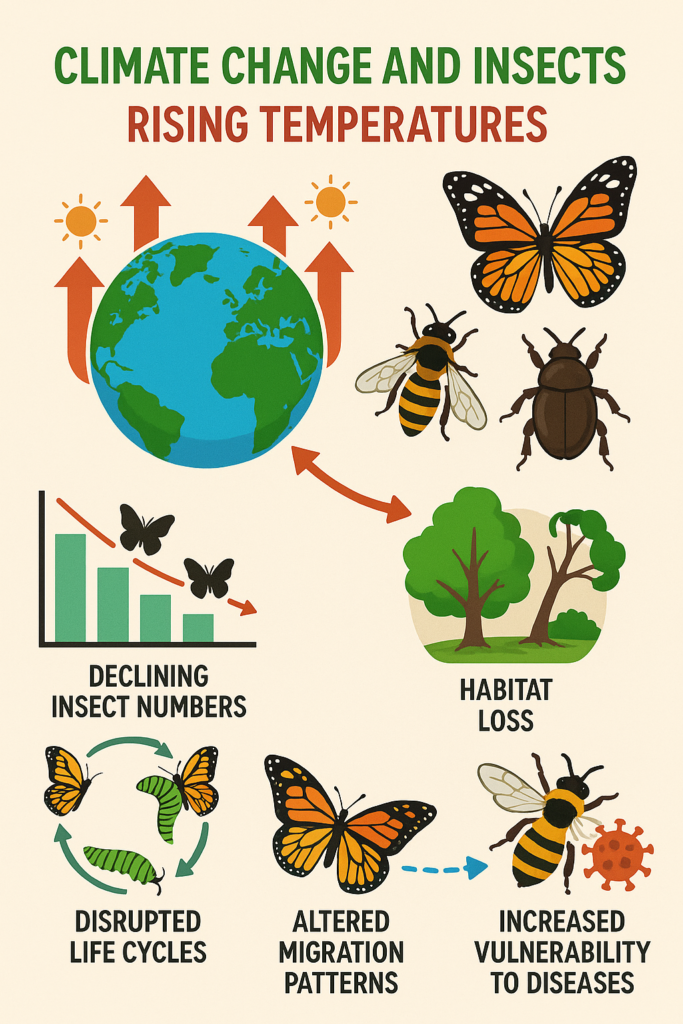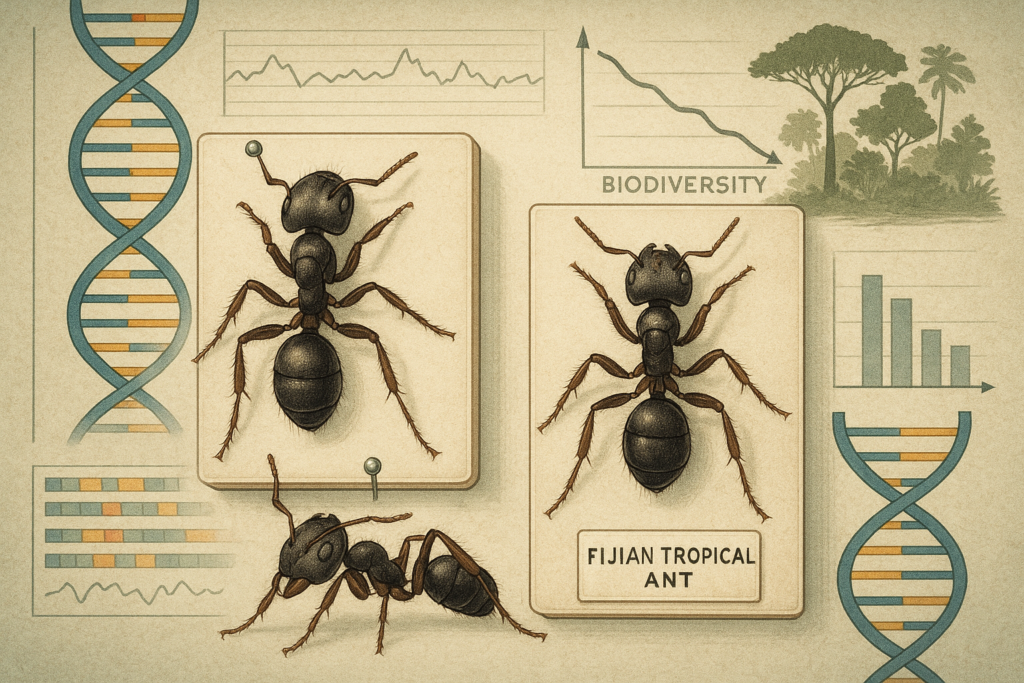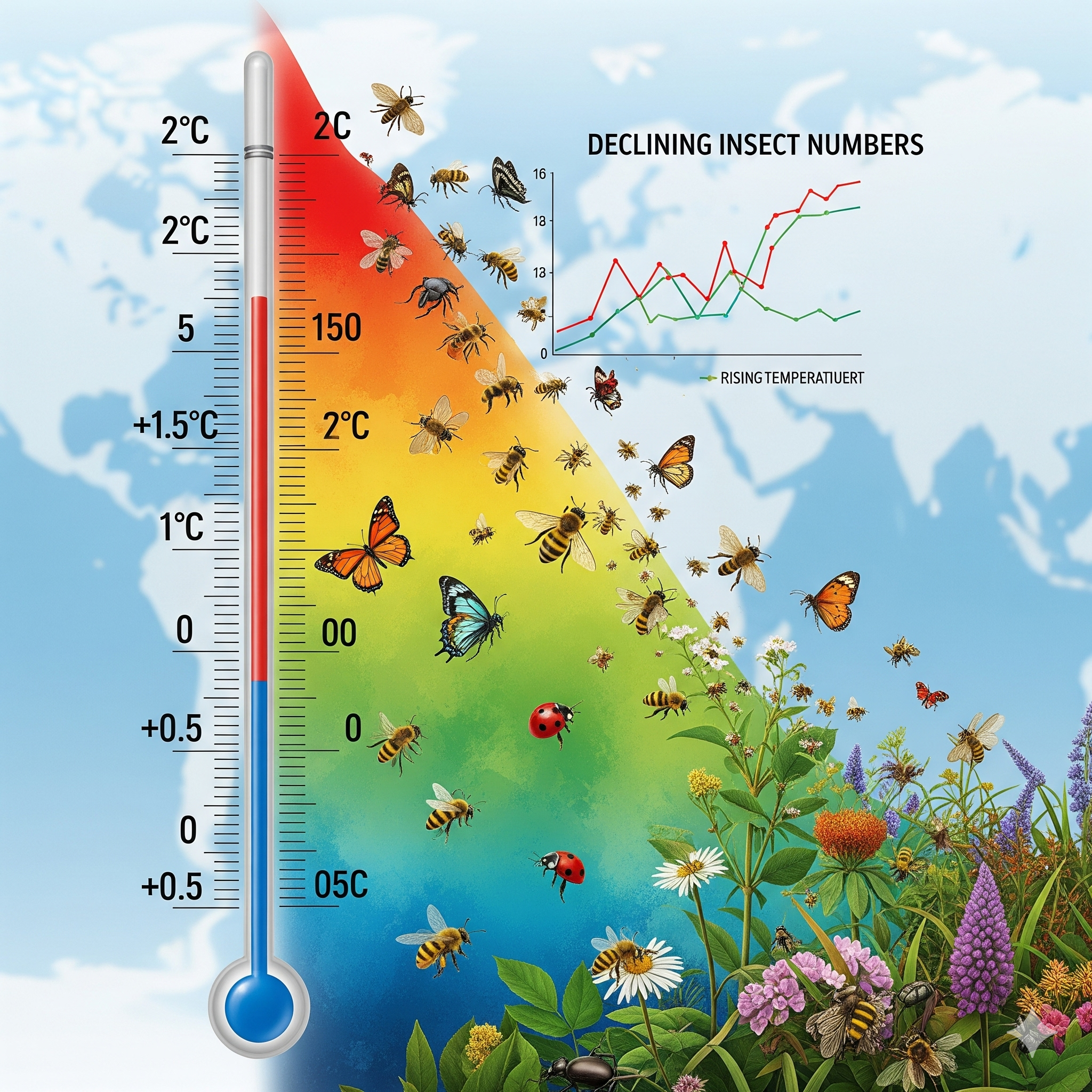Key Highlights
- Massive Decline: 72.4% drop in flying insect populations over 20 years in remote Colorado meadow, with 6.6% annual decrease
- Climate Connection: Rising summer temperatures strongly correlated with insect population crashes, particularly daily minimum temperatures increasing 0.8°C per decade
- Global Evidence: Fiji study reveals 79% decline in native ant species using museum genomics, with human arrival accelerating losses
- Economic Impact: Insect pollination contributes $477 million annually to Nepal’s agriculture (9% of total revenue), highlighting economic consequences
- Universal Threat: Even protected, pristine ecosystems face severe biodiversity loss, indicating climate change as primary drive
A Window into Pristine Ecosystem Collapse

In the remote subalpine meadows of Colorado, far from direct human interference, a devastating ecological transformation has been quietly unfolding. Associate Professor Keith Sockman of the University of North Carolina at Chapel Hill documented one of the most comprehensive long-term studies of insect decline in a relatively untouched ecosystem.
Methodology and Scope
Over 15 field seasons spanning 2004-2024, Sockman meticulously tracked flying insect abundance in a Colorado meadow with 38 years of available weather data. The location’s isolation from farming, pollution, and urban expansion made it an ideal natural laboratory for understanding climate-driven ecological changes. esarjournals
Data Collection: Using standardized trapping methods, researchers captured and quantified various flying insects including flies, bees, moths, and other aerial arthropods. npr
Environmental Controls: The study site’s minimal human disturbance eliminated confounding variables, allowing researchers to isolate climate impacts from habitat destruction.
Statistical Analysis: Researchers analyzed 59 combinations of weather-related factors using information-theoretic approaches to identify key drivers.
Shocking Results
The findings revealed an alarming average annual decline of 6.6% in insect abundance, culminating in a staggering 72.4% reduction over two decades. This rate of decline exceeds global estimates and occurs in an environment with minimal direct human interference.
Temperature Correlation: The strongest predictor of insect decline was previous summer’s temperature, particularly rising daily minimum temperatures. ncbi.nlm.nhi
Lag Effects: Warmer summers preceded lower insect counts in subsequent years, suggesting complex physiological and ecological mechanisms.
Broader Implications: The magnitude of decline in this pristine environment suggests climate change may be driving insect losses more extensively than previously understood.
Climate Change: The Hidden Culprit

The Colorado study provides compelling evidence that climate change serves as a primary driver of insect decline, even in ecosystems largely shielded from direct anthropogenic disturbance.
Temperature-Driven Mechanisms
Physiological Stress: Rising temperatures exceed thermal tolerance ranges for many insect species, affecting survival, reproduction, and development.
Life Cycle Disruption: Temperature increases alter timing of critical life events, creating mismatches between insect emergence and food availability.
Metabolic Impacts: Higher temperatures increase metabolic rates, potentially exceeding energy budgets and reducing survival rates.
Habitat Quality: Elevated temperatures may degrade habitat quality through changes in vegetation composition and structure.
Ecosystem Cascades
The decline of insects in pristine environments triggers cascading effects throughout food webs:
Predator Impacts: Birds, bats, spiders, and other insectivores face reduced prey availability.
Plant Pollination: Reduced pollinator populations threaten plant reproduction and ecosystem stability. downtoearth
Nutrient Cycling: Decreased insect decomposer activity slows nutrient cycling processes.
Food Web Simplification: Loss of abundant insect species simplifies ecosystem structure and reduces resilience.
Global Evidence: The Fiji Ant Study
Complementing the Colorado research, a groundbreaking study in Fiji revealed similar patterns of decline using innovative museum genomics approaches.

Museum Genomics Revolution
Researchers at the Okinawa Institute of Science and Technology analyzed over 4,000 ant specimens from museum collections, employing cutting-edge sequencing techniques called “museomics”.
DNA Fragment Analysis: Despite DNA degradation in old specimens, researchers successfully extracted genetic information to track population changes.
Community-Wide Assessment: The study simultaneously analyzed multiple species, providing unprecedented community-level insights.
Historical Reconstruction: Genetic signatures revealed population trends spanning thousands of years of colonization history.
Devastating Findings
The Fiji study uncovered alarming patterns of native species decline:
79% Species Decline: Nearly four-fifths of endemic ant species show population contractions.
Human Arrival Impact: Declines began approximately 3,000 years ago with initial human settlement and accelerated dramatically over the past 300 years.
Invasive Species Success: Non-native ant species introduced by humans show population expansions, creating ecological imbalances.
Habitat Specificity: Endemic species confined to high-elevation intact forests face the greatest threats.
The Indian Context: Himalayan Biodiversity Under Threat
India faces particularly severe challenges from climate-driven insect decline, especially in the Himalayan region.
Himalayan Ecosystem Vulnerability
The Hindu Kush Himalayas experience rapid warming, with temperatures rising 0.2°C per decade and projected increases of 2-5°C by 2050.
Altitude-Dependent Warming: Higher elevations experience more severe temperature increases, threatening endemic species.
Species Range Shifts: Many insects, including Apollo butterflies and various ant species, show altitudinal migrations or population declines.
Pollinator Crisis: Himalayan bumblebees face habitat loss, with less than 10% of suitable habitat remaining for 72% of species by 2050.
Agricultural Implications
India’s agricultural sector faces mounting challenges from pollinator decline:
Crop Yield Impacts: Studies indicate clear linkages between pollinator abundance and vegetable productivity.
Economic Losses: Reduced pollination efficiency threatens food security and farmer livelihoods.
Regional Variations: Different agro-ecological zones experience varying degrees of pollinator limitation.

Ecosystem Services: The Hidden Economic Crisis
Insect decline threatens ecosystem services worth billions of dollars globally, with India particularly vulnerable due to its agricultural dependence.
Economic Valuation
Global Estimates: Wild insects provide approximately $57 billion annually in ecosystem services in the United States alone.
Regional Values: In Nepal, insect pollination contributes $477 million yearly to agriculture, representing 9% of total agricultural revenue.
Service Categories: Insects provide provisioning services (food, medicine), regulating services (pest control, pollination), supporting services (nutrient cycling), and cultural services.
Critical Ecosystem Functions
Pollination Services: Insects pollinate approximately 75% of global crops, with economic values reaching hundreds of millions in developing countries.
Pest Control: Natural predators and parasitoids provide billions in agricultural pest management services.
Nutrient Cycling: Decomposer insects process organic matter, maintaining soil fertility and ecosystem productivity.
Food Web Support: Insects serve as primary food sources for countless vertebrate species.
Conservation Challenges and Policy Responses
Addressing climate-driven insect decline requires comprehensive policy approaches spanning conservation, agriculture, and climate adaptation.
Protected Area Limitations
The Colorado and Fiji studies demonstrate that traditional protected area approaches may be insufficient:
Climate Penetration: Protected areas cannot shield species from global climate change effects.
Buffer Zone Needs: Surrounding landscapes increasingly influence protected ecosystem integrity.
Connectivity Requirements: Climate adaptation requires landscape-scale habitat corridors.
Adaptation Strategies
Assisted Migration: Moving species to suitable habitats as climate zones shift.
Habitat Restoration: Creating climate-resilient habitats with diverse microclimates.
Agricultural Integration: Developing pollinator-friendly farming practices.
Monitoring Networks: Establishing long-term insect monitoring programs.
Future Research Directions and Global Cooperation
Addressing the insect decline crisis requires coordinated international research and policy responses.
Research Priorities
Global Monitoring: Establishing standardized insect monitoring protocols across diverse ecosystems.
Mechanistic Studies: Understanding physiological and ecological pathways of climate impacts.
Adaptation Research: Identifying species and ecosystem resilience factors.
Economic Valuation: Quantifying ecosystem service losses for policy development.
Policy Integration
Climate Mitigation: Integrating biodiversity concerns into greenhouse gas reduction strategies.
Agricultural Policy: Promoting pollinator-friendly farming practices and habitat conservation.
International Cooperation: Developing global frameworks for insect conservation.
Sustainable Development: Aligning conservation goals with poverty alleviation and food security objectives.
Conclusion: Urgent Action in the Face of Silent Crisis
The evidence from Colorado’s pristine meadows and Fiji’s remote islands delivers a sobering message: climate change is driving insect decline across the globe, even in areas with minimal direct human disturbance. The 72.4% population crash in Colorado and 79% species decline in Fiji represent canaries in the coal mine for global biodiversity.
This crisis extends far beyond scientific curiosity. With insects providing hundreds of billions of dollars in ecosystem services globally and supporting the foundation of terrestrial food webs, their decline threatens agricultural productivity, ecosystem stability, and human wellbeing. India, with its diverse ecosystems and agricultural dependence, faces particular vulnerability.
The research highlights several critical needs: expanded monitoring programs to track insect populations, landscape-scale conservation strategies that account for climate change, and integrated approaches that address both mitigation and adaptation. The innovative use of museum genomics demonstrates how historical specimens can unlock new insights into long-term ecological trends.
Perhaps most importantly, these studies reveal that traditional conservation approaches focused solely on habitat protection are insufficient. Climate change penetrates even the most remote ecosystems, requiring global cooperation to address root causes while developing adaptive strategies for species and ecosystem resilience.
Key Terms:
- Ecosystem Services: Economic and ecological benefits provided by natural systems
- Phenological Mismatch: Temporal disconnect between species interactions due to climate change
- Museum Genomics: Extracting genetic information from preserved specimens
- Pollinator Limitation: Reduced plant reproduction due to insufficient pollination
- Community Genomics: Analyzing multiple species simultaneously to understand ecological patterns
Analytical Framework:
Geography and Environment
- Biodiversity Hotspots: Understanding ecosystem vulnerability in Western Ghats, Himalayas, and other critical regions.
- Climate Change Impacts: Analyzing sector-specific effects on agriculture, forestry, and coastal ecosystems.
- Biogeographical Principles: Applying island biogeography concepts to fragmented landscapes.
General Studies Paper III: Environment and Ecology
- Ecosystem Services: Evaluating economic and ecological importance of biodiversity conservation.
- Agricultural Sustainability: Assessing pollinator-dependent crop security and rural livelihoods.
- Conservation Strategies: Analyzing effectiveness of protected area networks and landscape-level planning.









+ There are no comments
Add yours